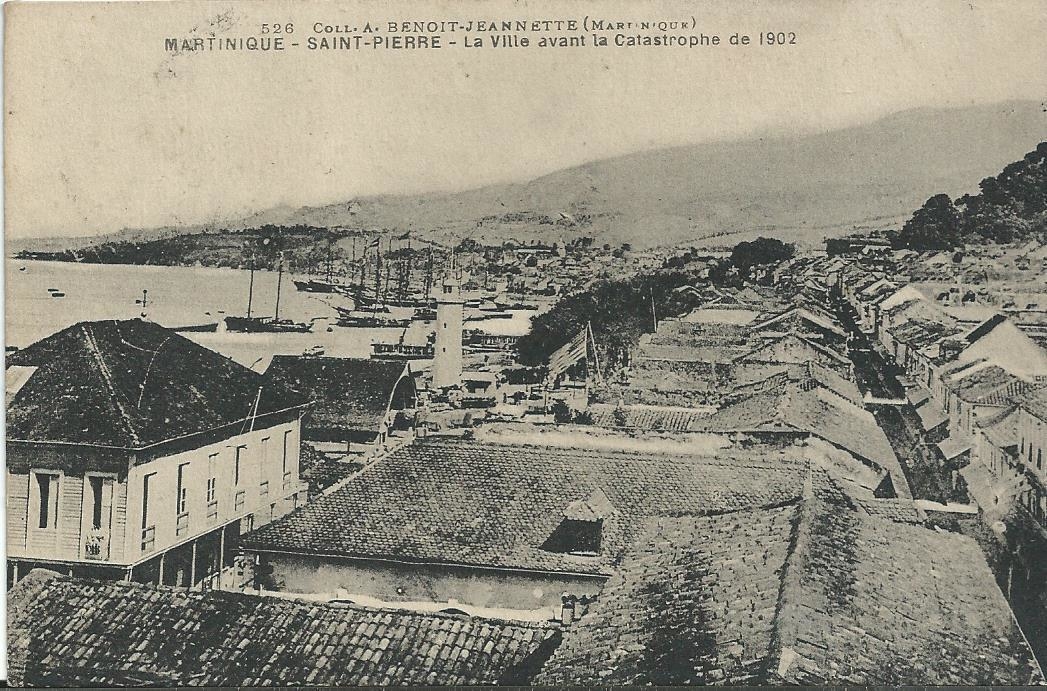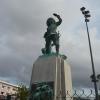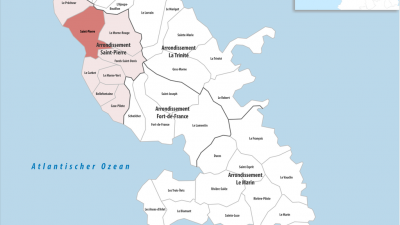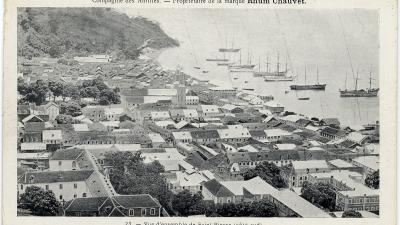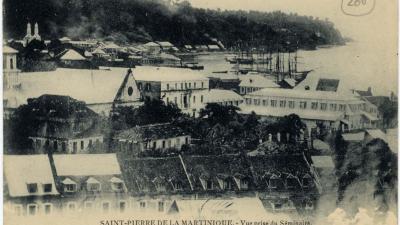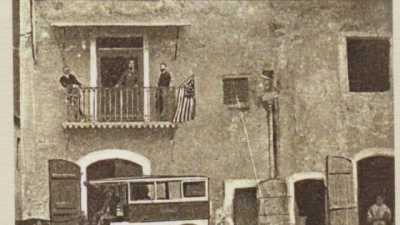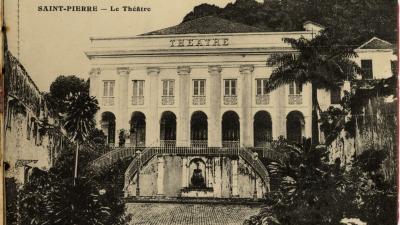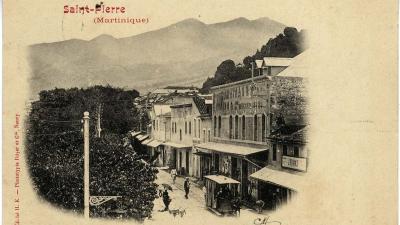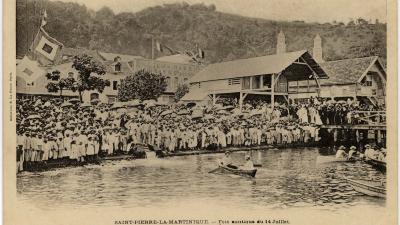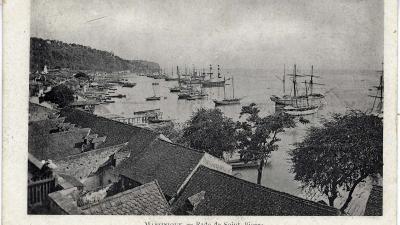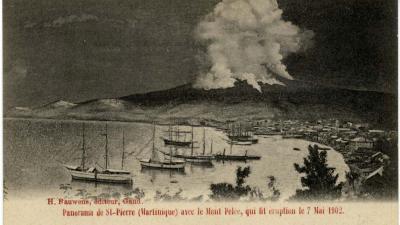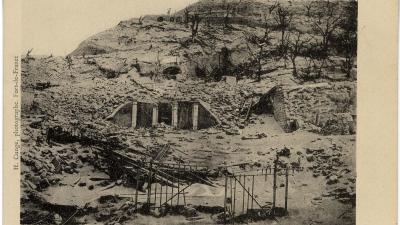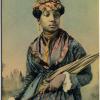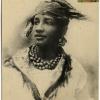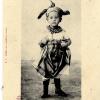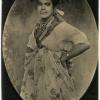- It was established in 1635 by the French buccaneer Pierre Belain d’Esnambuc.
-
It’s success was due to being on the sailing routes between Europe & the New World; the depth of the bay so close to shore; relatively protected harbour from the Atlantic swell & permitting easy access by sail. A success sustained by its extensive business structures, port administration and its vibrant lifestyle.
-
Steamships later preferred Fort de France as a base (safety from storms, naval & port infrastructures, space) but St. Pierre was an obligatory stop for all vessels.
-
A large industrial base was established:
-
16 rum distilleries (principally industrial rum from molasses but also the traditional French rum made from the cane juice consumed locally).
-
Manufacturer of fertilizer; Steel foundry; Wood factory; Ice making factory; Modern centralized sugar factory (Guerin).
-
Running water everywhere in the town
-
-
Buildings all made of stone delivered a strong impression of rock-solidity.
-
Houses of 2 – 3 stories built in stone established by plateaus rising from the shoreline up to the hills, painted in clear yellow with shutters in striking green or grey-blue - a paradise for an aquarelle artist.
-
26.000 inhabitants + 7.000 people in the surrounding countryside representing ~20% of the population of Martinique.
-
Contained ~70% of Martinique’s elite, merchants, industrials, intellectuals, and its cathedral.
-
3 newspapers; several banks; Lloyds insurance agency; 6 consulates including the USA; 800 seat theatre created by 4 wealthy businessmen; an active Astronomical society; a horse driven tramway.
-
Its renowned carnival brought visitors from the USA and the rest of the Caribbean who were a significant source of revenue for the town
- Principal port and distribution centre for the Caribbean islands (lesser antilles) with ~440 hundreds of vessels/year.
-
In number English vessels were in the lead in 1897, followed by French, Italian, American, and Dutch flags.
-
The lungs of the colony: ~100% of imports and exports for Martinique distributed by small craft along the coast (eg. Fort de France) & to the surrounding islands.
-
By comparison, Fort de France was the administrative centre of Martinique due to its naval base with its defence infrastructures & security from hurricanes was increasingly attracting the new steamships. But its population was only ~7.000 people with a water supply & general living condition of poor quality.
-
St. Pierre was accessible principally by sea & with difficulty by land via only two roads that were not paved. A massive evacuation of the population was as such not conceivable nor was it conceived as this kind of volcanic eruption was not yet understood.
-
St. Pierre built its society based on being at the leading end of ideas, industrial & medical techniques; hard working ethic; dignity and elegance; and the vibrancy found in a totally mixed population.
-
6 different clubs or circles for men and 2 for women; 3 masonic loges
-
10 charitable organizations; Leading edge Sanitary hospital for ~250 people
-
World-class Botanical Garden & laboratory established in 1803
-
Running water in the houses, on the streets; many water fountains all providing a clean cool environment & constant sound of flowing water.
-
Electric light and telephones in use.
-
And all of this in a melting pot: Separation of the Church & State with the public school system open to everyone; Conflict and violence of the transition from a slave society ended in 1848; The arrival of democratic voting; The sugar price crises with the rebound to produce rum – St. Pierre became known as the capital of rum with some 16 refineries.
ST. PIERRE’S CARNAVAL – Renowned far & wide
-
The Créole songs (« Chansons Créoles ») were extremely popular and of the same nature as the « Calypso’s » also very popular in Trinidad & the English islands:
-
Made fun of events: political, people, sexual transgressions .... with very vivid & pertinent descriptions that were never shaken off!
-
Ex. An American – Colby – came to show off he could fly in a balloon to 5.000 ft. Balloon flew but split & he ended up in the bay of St. Pierre. “Colby monté, Colby désann ..” For several years any such event became a Colby story.
-
All sung to dance catching rhythms of the biguine, mazurka and polka with the women swinging their hips…
-
St. Pierre saying “We do not become artists; we are born artists”
-
Carnaval began one month before Ash Wednesday
-
Floats were in mid Lent
-
The float « The Honeybee » won the last one
-
Monday was in red devoted to the devils & witches, all dominated by « Le Vieux » devil covered in mirrors and followed by a witch dragging a cooking pot attached to her leg – beware of being seduced by her as you risk to lose your life! Followed by a horde of children and adults dancing and making frightening guttural cries.
-
Mardi Gras by 2 PM everyone appeared in their most beautiful or simplest of costumes & masks, all expressing themselves in the folly of carnival…
-
Wednesday everyone was in black & white and the « Bois-Bois » was carried and burned at midnight ending carnival and the return of order.
The Theatre was the centre of cultural and societal events in St. Pierre
-
Visiting Opera troupes enriched the music scene as their classical music was converted into popular dance rhythms:
-
Le Trouvère by Verdi gave birth to the Mazurka dance song « Ô ma patrie, Ô chère Espagne »
-
La Favorite by Donezitti brought forth « Tjé mwen ka fé mwen mal » (My heart hurts me).
-
It was a hotbed of carnival dancing and encounters; in its lodges many virtues were lost….Sunday gras, those with masks started to collect together by lunchtime, quickly joined by all and sundry and in a variety of costumes from the sophisticated to the bare minimum. Three competing musical groups appeared, and the dancing and bacchanal went on late into the night.
“BIGUINE” - A MUSICAL RYTHME CREATED IN ST. PIERRE
-
This musical rhythm & dance was created in St. Pierre and underlies many of the carnival songs “Chanson Créoles” for which St. Pierre became renowned. These songs made fun of life, its people, events, and the most pertinent ones lasted many years.
-
Captured on film during the 100th anniversary of St. Pierre in 2002 the film covers the encounter of the country “bélé” music based on the flute and the drum with the classical music emanating from St. Pierre’s theatre and its wealthy homes. The visiting opera & theatre troops came with a reduced set of actors & musicians incorporating local people to complete the performance troop so setting the stage for a transfer of these artistic talents.
-
Over time the very adept but illiterate musicians using their musically attuned ears first started using these European instruments to play the classical music & dance that the wealthy wanted. Then when gathered with their own people these classical rhythms were blended with their traditional “belé” music adding the sounds of the clarinet, trombone & trumpet instruments creating the Biguine dance music for which St. Pierre is renowned.
Volcanic events leading to the disaster.
February - May 1902 – The region trembles
-
February: Earthquakes start in Central America; volcanoes follow.
-
March: Seismic activity started in St. Vincent in the Soufrière volcano. The Caribs in the North recalling the impact of the explosion of 1812 want to move their village.
-
24th April Mt Pelé begins to emit vapor from its summit
-
27th April – first round of elections for Martinique’s representation in the French House of Representatives in Paris
-
30th April – St. Pierre trembles in a strong earthquake
-
2nd May – Huge black cloud obscures the sun over St. Pierre; ash & sulphurous gases descend on the area
-
3rd May – Volcanic activity gets stronger; first wave of ash & water descends the river
-
5th May – Sugar factory (Usine Guerin) to the North of the town is pushed into the sea – 30 lives lost
-
6th - 7th May, pyrotechnic displays, violent thunderstorms denote the impending disaster. The authorities remain convinced that lava flows will not reach St. Pierre. The Governor of the island & his wife arrive in St. Pierre to show his confidence. People from the countryside continue to arrive seeking the perceived protection of the solidity of St. Pierre.
-
7th May ~15:00 – St. Vincent - Soufrière mountain erupts with ~2.000 victims.
THE DAY OF THE DISASTER
8th May 1902 – Ascension Day – A tale of fact & fiction
-
The ceremony of Communion maintained at 08:00 despite all the volcanic activity.
-
Louise (who lost her husband in the Guerin factory on May 5th) is up at 5 AM as usual to go to work carrying her tray of goods to sell. She prepares all the beautiful clothes for her daughter Julciane’s communion - her grandmother will supervise her dressing.
-
At ~7:45, Julciane, her father, his wife, her grandmother with the other families enter the cathedral.
-
~08:00, Mont Pelé explodes sending in the direction of the town a high-speed cloud of heated gas, ash & stones annihilating all that is in its path. ~28.000 people die instantly.
-
Louise is knocked out near the beach in the neighbouring village of the Carbet; Her husband’s best friend finds her alive and carries her to his home.
-
Days later they enter the remnants of the cathedral and find her daughter, her father, his wife and her grandmother in a protective embrace – their bodies were spared the direct consequences of the blast; the overheated gas had destroyed their lungs.
-
They later marry and re-start a family to replace those that they both lost at St Pierre.
Source: “Le bonheur l’attendait ailleurs” (Happiness was waiting for her elsewhere), a novel by Leo Ursulet, historian, and organizer of the scientific conference of the 100th anniversary of St. Pierre.
